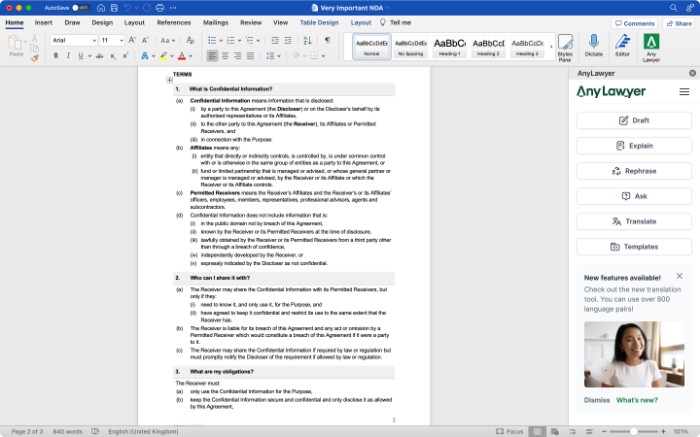For any business, mitigating risk is the key to success. Unanticipated losses can be disastrous to a venture. Contract risk management, in particular, is one of the most important strategies for avoiding major losses associated with contracts.
Knowing how to effectively manage and reduce risk associated with contractual agreements is an essential step in any successful business venture. With the help of legal AI and various best practices, businesses can identify and mitigate legal risk before it leads to unfortunate consequences.
What is risk management?
Risk management is the process of identifying, assessing, and controlling potential losses associated with a business venture. It involves doing research and evaluating data to determine how much risk is involved in an endeavor and strategizing ways to minimize those risks. Risk management also covers implementing policies and procedures that can help reduce the impact of any negative outcomes from taking risks.
What is contract risk management?
Contract risk management is the process of understanding, assessing, and mitigating any potential risks associated with contractual agreements. It involves analyzing all parties’ obligations and responsibilities under a contract to determine where potential risks might arise. This includes studying the language of the agreement, anticipating future events that could affect it, and strategizing ways to reduce the likelihood of any risks arising from it.
By taking a proactive approach to contract risk management, businesses can protect themselves from costly losses associated with contractual agreements. For example, through careful analysis and proactive prevention companies can avoid non-performance or breach of contract issues, fraud, and other common contract risks.
Who is involved in contract risk management?
Contract risk management typically involves many people. This includes legal teams and contract law experts, skilled negotiators, compliance teams, and business professionals with an eye for detail. Each person involved brings different skills to the table, making it essential to have a well-rounded team that can assess potential risks and strategize ways to minimize them.
Legal experts bring a deep understanding of the language of contracts and any potential legal traps associated with them. Skilled negotiators have experience in ensuring that both parties are satisfied with the agreement. A compliance team can help protect companies from fraud and other risks associated with contract enforcement. Business professionals can provide perspective on how the contract will affect the company’s operations and finances, as well as strategize ways to reduce potential risks.

What are some common contract risks?
Common contract risks include a variety of issues, such as non-performance or breach of contract issues, fraud, and data leakage. To avoid these potential risks, businesses should thoroughly assess each agreement and strategize ways to reduce the likelihood of any losses arising from them.
Non-performance or breach of contract
This can occur when one party fails to fulfill its obligations under the agreement, and it may lead to financial losses and legal disputes.
Fraud
Fraud is another potential risk that businesses should be aware of when entering into agreements. This includes fraudulent representations or omissions, concealed information, and other deceptive practices.
Security risks
Data leakage, hacking, and other cyber security issues can pose a significant risk to businesses. To reduce this risk, businesses should ensure that appropriate security measures are in place.
Data leakage
Data leakage can occur when sensitive information is shared with an unauthorized party. It can lead to costly liabilities, high administrative fees, and reputational damage. This is particularly common when there is no secure contract repository, and the contract information is instead dispersed through shared files and emails. Such data can easily fall into the wrong hands through oversight, not to mention true malicious intent.
Intellectual property issues
Intellectual property issues can arise when a business’s confidential information is shared without proper authorization. Common cases include unlawful use of another brand or IP, as well as using another company’s know-how despite contractual restrictions. Businesses should ensure that all intellectual property is properly protected in their agreements.
Changes in the industry
The industry in which a business operates can change over time, and businesses need to be aware of potential risks associated with those changes. This could include changes in regulations or in the competitive landscape that could affect their ability to fulfill contractual obligations.
Regulatory compliance concerns
Businesses should be aware of any potential regulatory compliance concerns associated with their agreements. This could include local, state, or federal laws that must be adhered to in order to remain compliant.
Business interruption
Business interruption can occur when operations are disrupted due to a breach of contract or other issue. It is important for businesses to ensure that they have measures in place to minimize the risks associated with business interruption. This concern can be particularly valid for procurement and require appropriate early detection systems and fallback plans.
Operational delay
Operational delay can occur when one party fails to deliver on a contractual obligation in a timely manner. This can lead to costly schedule changes and make it difficult for businesses to meet their own commitments. Importantly, slow contract processing can be the cause of a delay.
Lack of business flexibility
Agreements should also be flexible enough to accommodate any changes that may be needed over time. This can help businesses stay competitive and avoid costly penalties associated with non-compliance.
Business insolvency
Business insolvency is another potential risk that businesses need to consider when entering into contracts. This can occur if a party fails to fulfill their obligations or becomes unable to pay due to financial difficulties. Effective contract management means that everyone is aware of their obligations and the contract's timeline.
Reputation loss
Reputational damage can occur when a business fails to meet its contractual obligations. This could lead to customers losing trust in the business and their products or services, which could have a lasting impact on their bottom line. The same is true for relationships with suppliers, partners, and team members.
Access to talent
Today's top talent are likely to pass on job offers from firms that have a bad reputation. Businesses should be aware of this potential risk and work to ensure that they are meeting their contractual obligations.
Onboarding and offboarding
When the composition of a team responsible for fulfilling contractual obligations changes, onboarding and offboarding become crucial processes for reducing risk. Onboarding needs to involve appropriate access to information, including knowledge about the contract, stakeholders, etc. When someone leaves, they need to be debriefed about protecting the sensitive information they will be, in a sense, carrying out into the world.
Late fees
Late fees or penalties can occur when a business fails to meet its obligations on time. These late fees can add up quickly and have major financial implications for businesses. To avoid this, businesses should ensure that they are meeting their deadlines and are aware of any potential consequences associated with late payments.
How can businesses mitigate contract risk?
Businesses can reduce the likelihood of potential losses associated with contractual agreements by thoroughly assessing each agreement and strategizing ways to minimize any potential risks. This includes making sure that all parties’ obligations and responsibilities are clearly outlined, anticipating future events that could affect the agreement, and carefully studying industry regulations.
Businesses can also improve their risk mitigation strategies by using legal AI to automate contract management. This should involve analysis of contract language, filtering out acceptable risk while flagging serious legal risks, compliance tracking, and more as part of contract lifecycle management.

Contract risk management best practices
Contract management includes a wide range of activities and processes, and one of them is risk management.
1. Prioritizing long term goals
It is important for businesses to ensure that their long-term goals are prioritized when entering into agreements. This means taking the time to carefully consider each agreement and its potential impact on future operations.
2. Keeping up to date with regulatory changes
Businesses should also be aware of any changing industry regulations or trends that could affect their contractual obligations.
3. Identifying potential risks
By carefully examining each contractual agreement, businesses can identify potential risks and take steps to mitigate them. This includes addressing issues such as business interruption, operational delay, lack of business flexibility, and reputational losses.
4. Standardization and automation
Businesses can reduce the risk of contractual losses by standardizing contract processes and automating contract management with legal AI and contract management software. Using AI and machine learning provides businesses with valuable insights into their contracts, enabling them to identify potential risks and take proactive steps to mitigate them.
Standardization and automation are also a great way to reduce and manage contract risk without making the risk management process so time-consuming it interferes with business goals. Reducing the impact of human error alone can be a big step towards lower risk scores.
5. Consistent language
It is a good practice to establish and use standardized language for all contracts. This can help ensure consistency and helps all parties to have a clear understanding of their rights and obligations under the agreement.
6. Knowing common risks
It is important for businesses to be aware of the potential risks associated with agreements and contracts. This includes understanding common risks such as business insolvency, reputational damage, access to talent, and legal liabilities.
7. Working with an experienced lawyer
Businesses should consider working with a qualified lawyer who specializes in contract law when negotiating or drafting contracts. An experienced lawyer can provide valuable advice and guidance on the various risks associated with contractual agreements, which can help protect a business from potential losses.
8. Rising company-wide awareness
It is important for businesses to ensure that all employees have a basic understanding of contract risk management and its importance to the company. This will help everyone mitigate risks associated with contractual agreements in their everyday work.
9. Avoiding overpromising
It is important to ensure that all contract obligations are realistic and achievable, as overpromising can lead to contractual disputes. Businesses should take into account the resources available, timelines, industry trends, and changing regulations when entering into contracts.
10. Limitation of liability clauses
Businesses should also ensure that their contracts contain limitations of liability clauses, which can help protect them from potential losses. These clauses can limit or exclude a party’s liability for certain types of damages or losses.
11. An effective contract review process
Businesses should have an effective contract review process in place to ensure that all contracts are thoroughly reviewed and assessed for potential risks. This can help prevent costly mistakes or disputes down the road. Using a contract review checklist or a contract playbook is a good idea.
12. Renewal reminders
Businesses should also use automated reminders to ensure that contracts are renewed or renegotiated in a timely manner. This can help them avoid potential losses due to forgotten contractual obligations or expired contracts.
13. Thorough approval workflows
All contracts should be approved by the appropriate stakeholders before being signed. An automated approval workflow can help ensure that all contracts are properly reviewed and approved in a timely manner.
14. Better transparency
Businesses should create contracts that are easily accessible and understandable by all parties. This can help reduce the risk of misunderstandings or disputes down the road.
15. Data security
Businesses should ensure that all contract data is securely stored and backed up to prevent loss or unauthorized access. This can help protect the company from potential losses associated with data breaches or other security incidents.
Utilizing legal AI in contract risk management
Legal AI can be used to automate contract management processes, helping businesses stay on top of any changes or potential risks associated with contracts. By embracing technology, businesses can reduce costs, increase efficiency and accuracy, and minimize the risk of costly losses due to contractual disputes.

Benefits of AI contract management tools
- Search and discovery: AI-powered contract management tools allow businesses to quickly and easily search through their contracts and related documents.
- Contract analysis: AI can analyze contracts in order to identify any potential risks or discrepancies.
- Automated compliance: AI can help ensure that all contracts are compliant with the applicable laws and regulations.
- Risk identification & forecasting: AI can be used to identify potential risks and provide predictive analytics for contract management.
- Cost & time savings: AI can help businesses save time and money by automating the process of creating, managing, and storing contracts.
- Standard clause and term libraries: AI can help businesses create and manage standardized clauses and terms, making contract negotiation much simpler.
By utilizing legal AI in contract risk management, businesses are able to reduce their risk exposure while increasing efficiency and accuracy.
Manage contract risk with the help of AI
Contract risk management is an essential part of any business. By understanding and properly managing contract risk, businesses can protect themselves from costly losses associated with contractual agreements. Through careful analysis, proactive prevention, and the use of legal AI, companies can minimize their exposure to potential risks and increase their chances of success in the long run.




